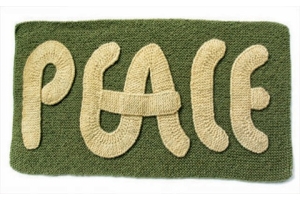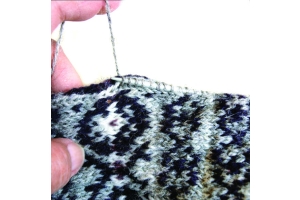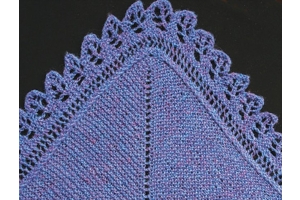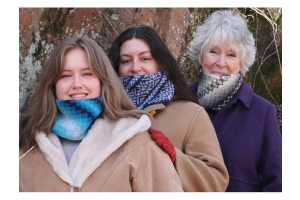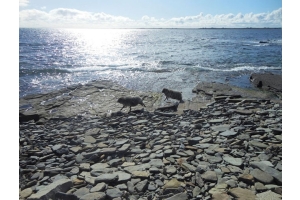Blog #8 Meg Swansen on Solstice Reading
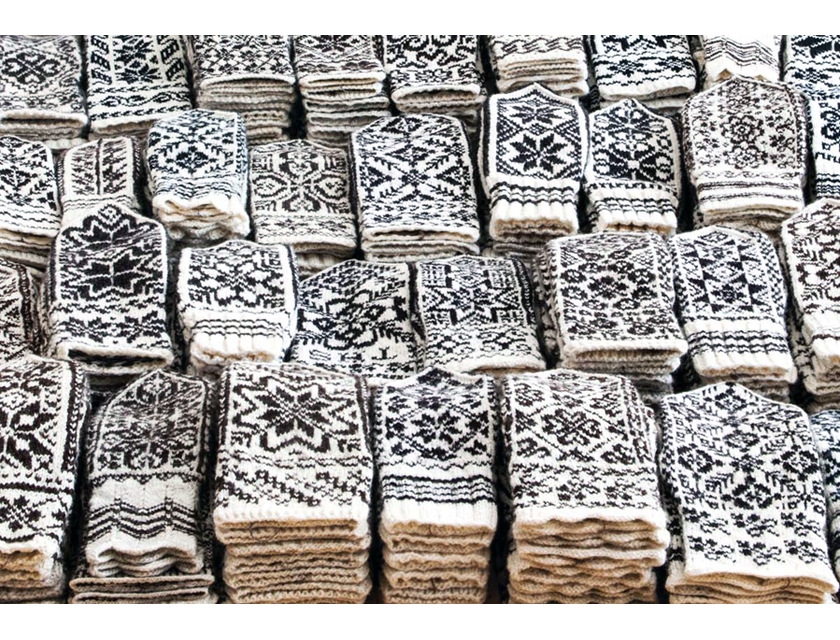
Solstice: Once Thanksgiving has melted away, the winter solstice comes toward us at great speed. Even though - from Dec 22 on - the days begin to lengthen in seemingly microscopic increments, I find it fitting to exchange presents with people we love in order to celebrate the gradually increasing bits of daylight.
We all know how recollections of holiday celebrations blur together over the decades, but I have particularly strong memories of receiving books for nearly each of the Christmases in my life. My mother mentions it in Knitter’s Almanac, page 138, “Envoi...These few days between Christmas and the New Year are for holding the breath, for sitting still and observing, for summoning energies against the future. There is a hush, unbroken even by the click of knitting-needles, although perhaps by the turning of pages of beautiful new Christmas books.” (I make it a point to read these pages each year at this time.)
For fellow bibliophile-knitters, this present period is an astonishingly rich one in the realm of knitting books. At Schoolhouse Press we stock all the titles that we particularly admire (that we know of), and like to make the less obvious European books available to our dear cussies. Yes, imported books are expensive, but nearly half the price is the cost to ship these tomes to the U.S. Gone are the days of linen M-Bags, when one could inexpensively send and receive large orders of books across the globe via ship. Today speed is everything and Air Mail, though faster, is pricier and is our only option.
The following books are also discussed in the accompanying video so you can get a glimpse of their contents. All of the books can be found in our Scandinavian & European books section on schoolhousepress.com
(I will focus on some excellent American books in my next entry.)
From Great Britain
Shetland Textiles, 800 BC to the Present, edited by Sarah Laurenson. I am practically speechless for, as the subtitle tells you, the entire span of Shetland textile history is covered herein, with wool being the connecting thread (pun intended). There are details of sheep, fleece, ‘truck’ knitting, tools, photographs of gorgeous knitted garments (no patterns included), weaving, splendid landscapes, lace knitting, rugs, and more sheep. These are all interwoven with fascinating and touching personal stories from nearly two dozen Shetlanders. You must see, read and feel the book for yourself. I am trying to limit myself to 10 pages per day, but the photographs lure one deeper and deeper into the text.
The Book of Haps chronicles, through articles and new designs, the history of hap shawls. A ‘hap’ is a Scottish and Shetland term for a shawl that was generally knitted with heavier wool, more garter stitch, and less lace. The original meaning was to ‘wrap’ or ‘cover’. “Combining textile history with contemporary design, this book explores the story of the hap through five beautifully illustrated essays, and thirteen stunning patterns." Kate Davies wrote most of the articles and organized the contributors to present this lovely new book.
Yokes, by Kate Davies presents eleven designs, plus stories of the sweater that changed the shape of modern knitting. I am particularly pleased to learn that Kate was heavily influenced by Elizabeth Zimmermann’s EPS; EZ is included in her dedication. And, the book includes an interview between Kate and me. (P.S. Kate’s Colours of Shetland is a great companion book.
Knitsonik Stranded Colourwork Sourcebook, A knitting book that shows you how to turn everyday inspirations into gorgeous stranded colourwork, by Felicity Ford. Upon seeing a splendid landscape, or garden, or grocery-store display, how many of us have had a flicker of knitting-design scamper across our brains? This is the mode used by Felicity Ford to conjure up her idiosyncratic and wonderful color patterns. For her inspiration, Ford uses biscuit tins, tree branches, row houses, fruit cake, and assorted other shapes and colors (colours). I particularly like the 8 Practical Exercises on page 11, which will cause you to 'see' anew. An altogether lovely and unique book.
A Shetlanders's Fair Isle Graph Book in Color, from the Shetland Guild of Spinners, Knitters, Weavers, and Dyers. Through this unique book, knitters are presented with a wealth of hand-drawn color-pattern charts, both Fair Isle and Norwegian. The archival pages (from the 1930s and 1940s) are reproduced from two journals which were used by Shetland knitters who worked for Anderson & Co. The charts are a product of their time; I was fascinated to find, rather than little colored dots in each grid-square, occasional areas of a single color sketched in as one block in crayon. Both the charts and the employment of color are "...classic, authentic Shetland Fair Isle patterns and colourways." Looking at the charts, I imagine I am seeing the motifs directly through the Fair Isle knitter's eye. Lovely!
From Scandinavia, Sweden and Norway:
Bohus Stickning på nytt, The Revival, by Viveka Overland. Through photos, letters, articles and interviews, Viveka Overland has provided us with more detailed historical information than we have had in previous publications, and we are able to follow more clearly the journey of this extraordinary movement which gave us the “...creative joy and beauty...” of Bohus knitting. Photos of 43 stunning Bohus designs that Solveig Gustafsson has carefully recreated from the originals and full instructions for 14 classic sweaters, several of which have been heretofore unknown to us ardent American Bohus-followers. Designs by Anna-Lisa Mannheimer Lunn and Kerstin Olsson, Emma Jacobson, Karin Ivarsson, and Annika Malmström-Bladini; multiple sizes for each garment, plus detailed charts, and matching gauntlet gloves for two of them. In English & Swedish.
[This new title is not to be confused with the original (out-of-print) Bohus Stickning book, which we imported in the 1970s. Plus, still in print, Wendy Keele’s beautiful Poems of Color kept Bohus knitting alive and available; it augments the new book beautifully.]
Jorid Linvik's Big Book of Knitted Mittens, 45 Distinctive Scandinavian Patterns. Along with a chapter of classic-style Scandinavian motifs, you will find dozens of non-traditional charts for an unusual assortment of animals - from giraffes to frogs. Some mittens have an animal on the back and, perhaps a paw-print on the palm. Or, knit half a sheep on the backs of each mitten, then put your hands together to see the whole animal. Plus cows, salamanders, rabbits, cats, owls, elephants and other surprises.
Selbuvotter, by Anne Bårdsgård. This staggeringly beautiful new book from Norway will ‘pin your ears back’ (as my mum used to say). Nearly 300 pages of charts and photos of these traditional Norwegian mittens and gloves which evolved from an original black and white mitten knitted by a young shepherdess in 1856. Who knew there was So Much variety in this historic design? For instance: photos of 40 different thumb motifs, over 350 photos and charts for mittens and gloves, page after page full of possible cuff motifs, over 60 charts for the narrow vertical divider between palm and back of mittens (!), over 120 palm motifs, etc. Thank you Jane Lippmann, for alerting me to this genuine treasure. In Norwegian, but the information transcends language.
[For more on the history of Norwegian mittens (witten in English), check out Terri Shea's lovely book, Selbuvotter: Biography of a Knitting Tradition.]
From The Baltics: Estonia, Latvia and Lithuania
Estonian Knitting 1, Traditions & Techniques, by Anu Pink, Siiri Reimann, Kristi Jöeste. This exceptionally beautiful book begins with knitting (and nålbinding) history and shows museum items from the 18th and 19th centuries: leg warmers, stockings, mittens & gloves, jackets & jumpers, underwear, caps, shawls & scarves. Tools & Materials is next, including color palettes used by eleven Estonian districts. Techniques offers an extensive verbal and visual treatise on over 20 subjects. The numerous varieties of twisted-braids alone may stagger you, along with color pattern charts, photos and charts for scores of texture patterns; increases and decreases, eyelets and travelling stitches, brioche and lace, slip stitch and entrelac, short rows and fringes, cables and nupps.
Here is another beautiful book of knitted lace from Estonia: Knitted Shawls of Aasa Joelaid. The author has knitted more than 1,300 Haapsalu shawls and scarves (!), and has created a number of original lace motifs, including her heart-shaped ‘nupp’ (that bead of wrapped wool that is so typical to Estonian lace). There are 61 charted motifs, nearly all containing nupps, plus drawings and verbal descriptions of all necessary techniques. Also, detailed charts (and sparse instructions) for 3 triangular shawls. In Estonian and English.
Mittens of Latvia, by Maruta Grasmane is an alluring hardcover book from Riga, recently translated into English. 178 designs from the mitten-producing districts of Vidzeme, Latgale, Augszeme, Zemgale and Kurzeme. It is clearly laid out with a close up photo on one page and the color-chart on the opposite page. Interspersed are photos of Latvians in traditional costume. (This is a wonderful adjunct to Lizbeth Upitis’ captivating classic, Latvian Mittens.)
Lithuanian Knitting, Continuing Traditions, by Donna Druchunas and June Hall. With strong ties to Lithuania the two authors celebrate the history and culture of that country. After 7-years of research, which included annual trips to that country, they produced this wonderful book. 14 mittens and gloves (choose ‘fringe’ or ‘Bulgarian’ cast-on), 10 socks and stockings (choose Lithuanian, Garter-stitch, or T-heels), and several beaded wristers.
From The Netherlands:
So Warm! Twined Knitting, by Carla Meijsen. Carla’s enthusiasm for, and expertise in the Swedish technique of *Twined Knitting is apparent. This type of knitting is thought to pre-date color-pattern knitting as a means to make a thicker, warmer garment. The comprehensive technical section provides over 150 close-up photos to teach you all the necessary details to knit her 30+ patterns for wrist warmers, mittens, mitts, gloves, hats, socks, leg warmers, boot toppers, etc. Here is a new challenge for experienced knitters and plenty of instruction for new knitters to master this ancient technique. In Dutch and English.
Dutch Traditional Ganseys, Sweaters from 40 Villages, by Stella Ruhe. This is an altogether splendid book, packed with history, old photo-graphs plus patterns for 60 (sixty!) garments. It is presented rather in the EPS mode; your hand is not held as you calculate your gauge to knit to your recipient’s measurements. It is beautifully produced in hardcover, on thick stock with lovely endpapers. I wrote a fan letter to the author and she kindly responded to tell me that many more patterns have surfaced since the publication of this edition, and she is at work on a follow-up book. I do love these traditional, unpretentious, forever stylish sweaters.

